The call of the wild: Cycling into Svaneti
Icy mountain passes and lofty peaks have kept everyone from the Romans to the Ottomans out of Georgia’s remote Svaneti region. But Olly Davy is on a mission to conquer it by bike
Our host warned us the road was impassable: “Sneg! Sneg!” he boomed, arms flailing to emphasise the severity of the snow that had fallen in recent days.
I smiled while my touring companion, Steve, explained in halting Russian that for us the only way was up, over the Zagar Pass at 2620m altitude and into Svaneti: a remote area famed for its wild beauty, stone towers and medieval villages. We had come a long way – it would take more than frozen water to stop us now.
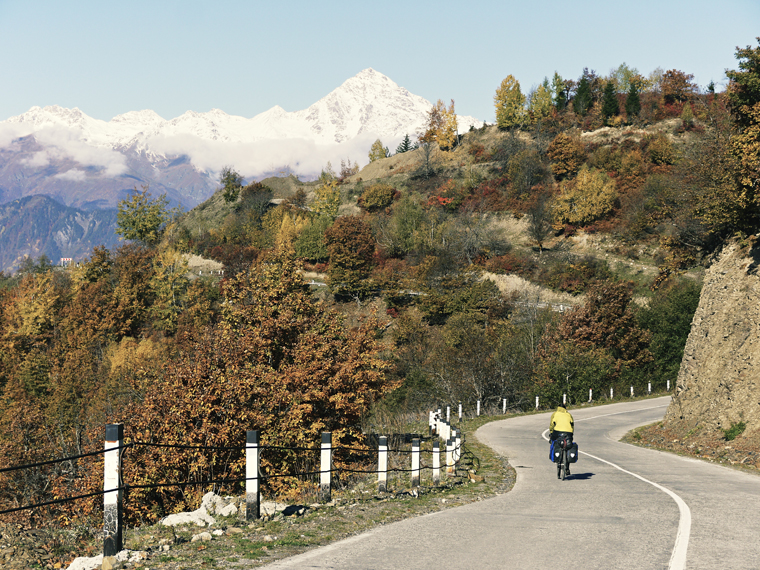
It’s all downhill from here – riding the good road from Mestia to Zugdidi
The Republic of Georgia is emerging from the shadows of its neighbours, Russia and Turkey. Cheap flights and improved infrastructure mean the country is more accessible than ever before. Consider Georgia’s self-designated status as the birthplace of wine (production dates back 8,000 years), and the Caucasus Mountains – a range Greek mythology declared as one of the pillars supporting the world – and you have a combination irresistible to the adventure-seeking tippler.
The catalyst for my month-long trip to the former Soviet Republic was the now or never opportunity to join my friend, Stephen Fabes, before the end of his six-year round-the-world cycle. Our plan was to complete a circuit of the country, including the most mountainous province, renowned for its indomitable inhabitants and considered by many to be the heartland of Georgian identity.
Throughout history powerful empires – Assyrian, Roman, Mongol, Ottoman – sent armies storming across Georgia, the frontier between Europe and Asia. But Svaneti, the home of the Svans, a lofty vastness surrounded by peaks 5000m high, remained unconquered until the Russians took control in the 1850s. Ironic that we should be lured to the region by the very stone towers and mountains that kept invaders away for centuries.
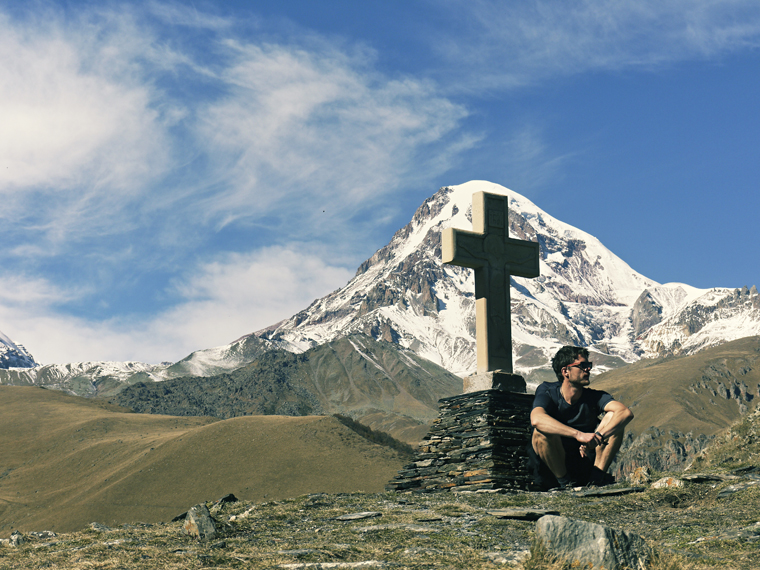
On route to the Gergeti glacier, Stepantsminda
Arriving late at night in the Georgian capital, Tbilisi, I dumped my gear in the packed dormitory. Battered rucksacks littered the space between mattresses, sprouting travel paraphernalia onto the floor like Gore-Tex weeds. Downstairs in the communal area I avoided conversation with a hairy drunk who waved his hand in the air and began, “You see, the problem with religion is…’ Ah, hostels!
Reunited after five years I was pleased to note that Steve was functioning normally. Although the fact he had named his threadbare cap Clive was a clue that perhaps some sprockets had come loose up top. As much as I mocked Steve for his shabby appearance and poor table manners, I envied his odyssey: conjured from maps into reality across six continents.
Our escape from Tbilisi was made in the rain through columns of traffic intent on our destruction. I wobbled nervously around manhole covers, and rejoiced in the complete ineffectiveness of my Sports Direct ‘waterproof’ shoe covers, which simply added another layer of wetness to my feet. I longed for the open road, away from the concrete snarl and drivers from whose lexicons the words ‘wing’ and ‘mirror’ were glaringly absent.
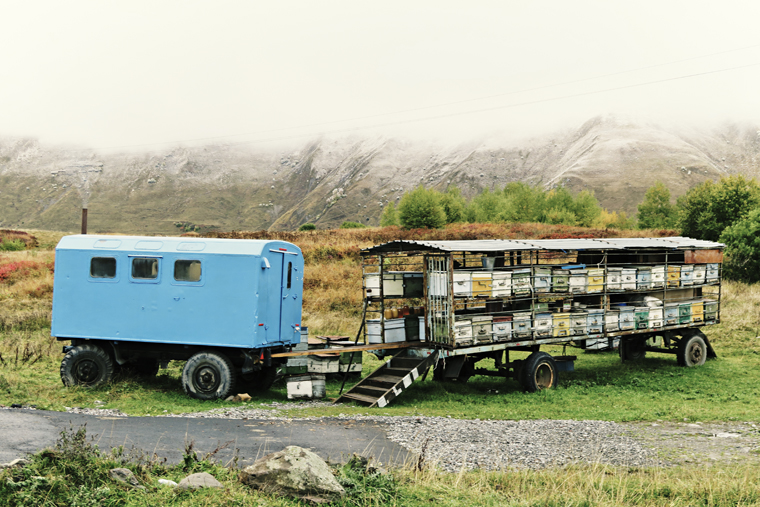
Roadside beehives on the way to Stepantsminda
We navigated by maps that mercifully had English as well as local spellings of place names. Georgian uses its own 33-letter alphabet, completely unintelligible to non-readers: snaking across the page with curves as frequent as the precipitous mountain roads.
Highlights of the first fortnight included an exploration of the Pankisi Valley. ISIS have found a fertile recruitment ground among the disaffected young male population here, but we received a warm welcome from locals mostly bemused by the two-wheeled tourists. Our closest brush with the Russian border came at Stepantsminda where we ditched the bikes for a spectacular day’s walking to the Gergeti Glacier.
We resigned ourselves to the daily nuisance of aggressive dogs but found consistent pleasure in Georgian food, which is exceptional and cheap. Almost every village had a small eating house where we tucked into piles of mtsvadi (lamb kebab) and tkemali (sour plum sauce). Khachapuri (a rich, doughy, cheese-filled bread) became our favourite snack. A hearty meal for two with drinks could be had for under 30 lari (about £9).
With every hour in the saddle my legs grew stronger. One day, with a tailwind, we clocked 140km. Svaneti was calling. We were unsure our chosen route – an unpaved track across a high-altitude pass – would be navigable in late October, and the knowledge that it had featured on the BBC programme Worlds Most Dangerous Roads added an extra frisson of excitement.
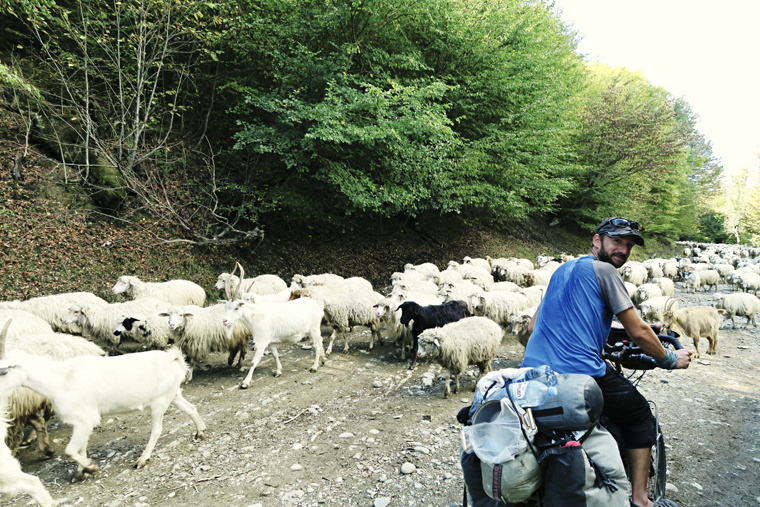
It’s not the sheep you need to worry about – it’s the sheepdogs
What better way to begin our assault on the highest mountain range in Europe than with bacchanalian overload? Georgians are renowned for their hospitality: a guest is a gift from God, goes the saying, and in the town of Dzevri we were invited to a traditional supra (feast). The tamada (toastmaster) orchestrated the drinking while we bent our heads over plates of badrijani nigvzit (fried aubergine with walnut paste) and lobio (kidney bean stew).
I watched in glassy-eyed wonder as our host, a giant of a man with a face like a cliff of flesh, probed the roasted head of a suckling pig with his shovel-sized hands, picking its bones clean over the course of the evening until only rows of teeth remained.
The following day the animal kingdom almost exacted an explosive revenge on its human violators. At Nikortsminda, once recovered from being driven onto the verge by a wedding party barrelling in convoy down both lanes towards us, we took a gravel track through the heart of rural Imereti. The sun dipped below the horizon, we chose a camping spot and settled down to cook.
I was chopping onions in the porch of my tent when I heard a cry: “Oi, no! Get away!” I dashed into the open to see a pig, 100kg and curious, charging towards the tent where Steve was lighting his petrol-fuelled stove. An altercation at that moment could have been disastrous so I ran at it, hollering and waving my arms. Presumably alarmed by my lycra cycling shorts, it waddled off to bury its nose in a cowpat.
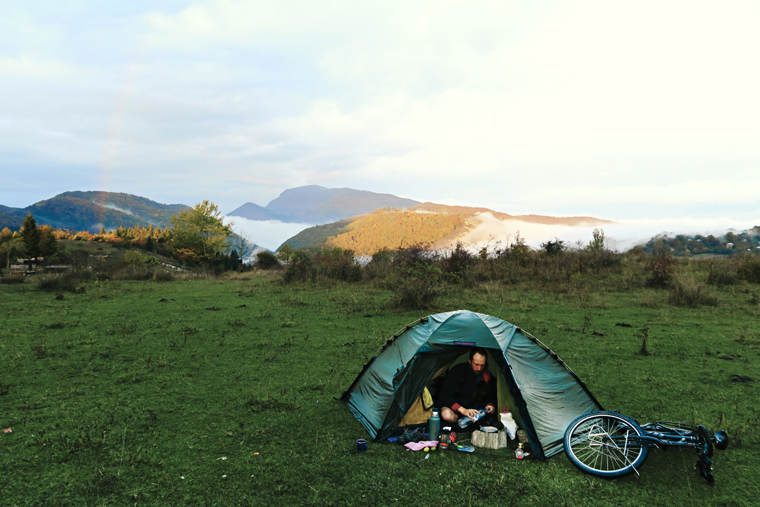
After the pig attack, Imereti province
The rain turned the track to an ice rink and the next day was a miserable slog. I was a tad resentful of Steve’s superior brakes as I struggled to control my second-hand Dawes Horizon down the slippery road. The bike proved itself a worthy steed but I was learning the hard way about the challenges of riding a laden machine with dropped handlebars on rough terrain.
It was a day of ‘miles not smiles’, as Steve put it, water dripping from his beard. Everything seemed grey and dreary, including the town of Tsageri where we stopped to find hot food. Stepping through an unmarked doorway, a plump woman in a greasy apron showed us to a back room where strings of flypaper dangled over the table, vibrating with half-dead victims. I braced myself for gastronomic meltdown.
My trepidation was repaid with the best kharcho (beef soup) I’ve ever tasted. No spoons were provided: we ate with lumps of bread, soaking up the rich spicy broth, slurping from the bowl, pouring warmth back into our bones until it ran down our chins.
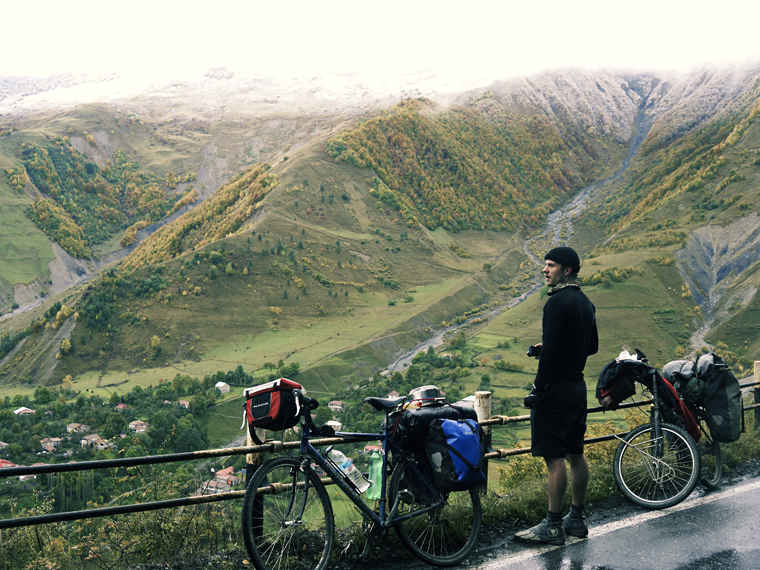
The road to Stepantsminda
By dusk we had reached Lentekhi where we paused to consider our next move. Suddenly, an angel appeared in the form of a local woman, shuffling across the square with an offer of bed and board. We rapidly abandoned our plan to cover maximum kilometres that day. Pushing the bikes in the wake of our saviour we passed rows of beehives and hazelnuts drying on the veranda before stepping into a cosy wooden guesthouse.
On hearing our plan to ride across the Zagar Pass, the woman’s husband became animated, brandishing a laptop displaying the local weather forecast and shouting about the snow. He offered to arrange a four-wheel drive vehicle to take us into Svaneti, but our resolve could not be shaken.
We set off at dawn. The tarmac ended after a few kilometres and we rode through deep mud and a straggle of farming communities. In one village an old man waiting for the school bus with his grandchildren pressed an apple into my hand and assured me there was no snow. Then there, unexpectedly, was Stalin: a concrete statue 15 feet high staring imperiously from between the trees. Proof perhaps that Georgia’s most infamous son is not universally reviled.
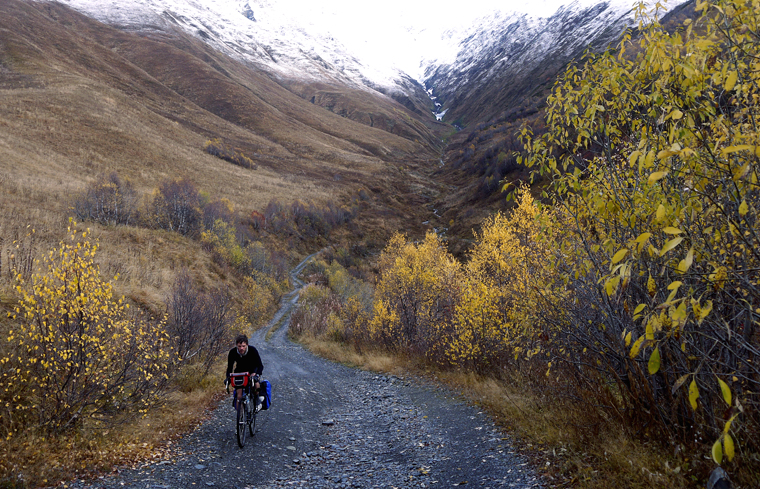
Climbing towards the Zagar Pass
After lunch the track rose sharply and with most of the weight at the rear it was a fight to keep the front wheel of my bike on the ground. I leant far over the handlebars to compensate. Sweat ran into my eyes as I forced the pedals down, tyres spinning in sludge or bouncing over rocks embedded in the dirt.
By mid-afternoon we realised there was no way we would make it over the pass that night. We camped near a derelict building, which I later discovered was an old Soviet arsenic processing factory: the rusting barrels scattered about were poisoning the earth where we slept with toxic waste.
The next day began with a severe climb – teeth gritted, thighs burning. Music was an essential motivator. My Motown greatest hits playlist came up trumps with Ain’t No Mountain High Enough.
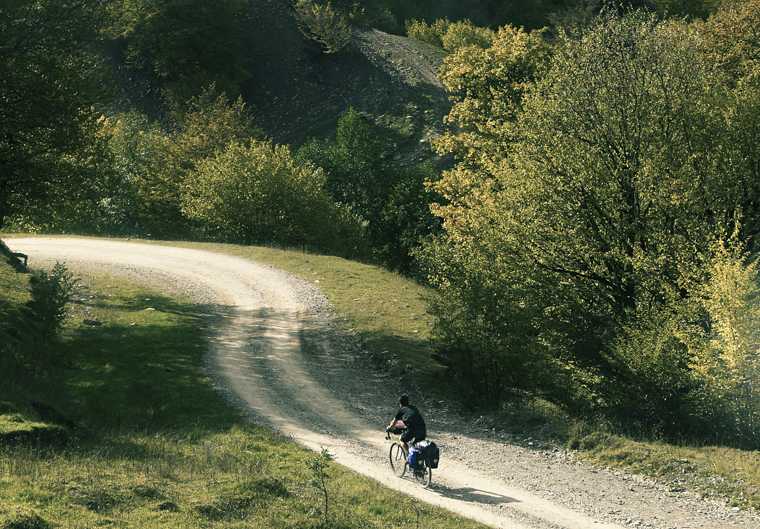
Leaving the Pankisi Valley
We followed the torturous track through forest while the weak sun fought battlements of shifting cloud, the forbidding faces of the mountains visible and hidden by turns. As the gradient lessened I regained my breath and gazed back through a field of waving golden grass to the vast blueness. The air was cold, the silence complete but for my pounding heart. I gave thanks for the unreliability of weather forecasting.
After the pass gravity gifted us rapid progress into Svaneti. Modernity has intruded on this inaccessible place, electricity arrived in even the remotest villages in 2012, but as we rattled near a cart drawn by two oxen it felt as if life had not changed since medieval times. At Ushguli in the shadow of a crumbling stone tower we dined on khachapuri once again and raised a glass towards Mount Shkhara, Georgia’s tallest mountain at 5193m.
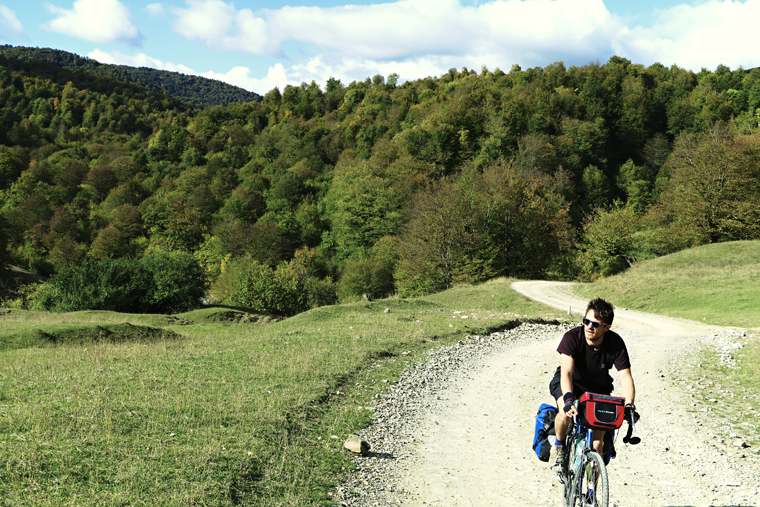
Empty tracks and glorious scenery are common in Georgia
We pitted ourselves against the gradients of the Caucasus and were rewarded with the welcome of strangers and access to a stunning high-altitude time warp. It’s clear why the Svans fought to defend these parts and why Georgian legend claims this is God’s own land.
Unfortunately, violent upheaval is not a thing of the past around here. With expansionist Russia rattling its sabre, Georgia’s borders are by no means secure. But resilience is a way of life in the Caucasus and its people just keep going, enduring the advances of belligerents from Genghis Khan to Putin. Whatever else the 21st century throws at them the Georgians will still gather for the feast, raise their glasses and shout “Gaumarjos!”
